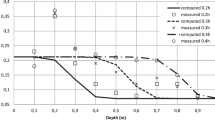Abstract
In this paper, we propose an efficient method for the identification of soil parameters in unsaturated porous media, using measurements from infiltration experiments. The infiltration is governed by Richard's nonlinear equation expressed in terms of effective saturation. The soil retention and hydraulic permeability functions are expressed using the Van Genuchten-Mualem ansatz in terms of the soil parameters. The mathematical algorithm is based on a transformation of Richard's equation to a system of ordinary differential equations completed by the governing equation for the movement of the wetness front. This system can be efficiently solved by specialized packages for the solution of stiff systems of ODE. The unknown parameters are determined using the optimization approach of minimizing a cost functional for the discrepancy between the model output and the measurements. The gradient and Hessian of the solution with respect to soil parameter vector are determined using automatic differentiation. Several numerical experiments are included.
Similar content being viewed by others
References
D.G. Aronson, Regularity properties of flows through porous media: The interface, Arch. Rational Mech. Anal. 37 (1970) 1–10.
L.A. Caffarelli and A. Friedman, Regularity of the free boundary for the one-dimensional flow of gas in a porous medium, Amer. J. Math. 101(6) (1979) 1193–1218.
J. Chen, J.W. Hopmans and M.E. Grisnier, Parameter estimation of two-fluid capillary pressure – saturation and permeability functions, Adv. Water Resources 22(5) (1999) 479–493.
D. Constales, Automatic differentiation in lsoda, in preparation.
S.O. Eching and J.W. Hopmans, Optimization of hydraulic functions from transient outflow and soil water data, Soil Sci. Soc. Am. J. 57 (1993) 1167–1175.
S.O. Eching, J.W. Hopmans and O. Wendroth, Unsaturated hydraulic conductivity from transient multistep outflow and soil water pressure, Soil Sci. Soc. Am. J. 58 (1994) 687–695.
B.H. Gilding, Flow and Transport in Porous Media(World Scientific, Singapore, 1992).
A.S. Kalašnikov, Formation of singularities in solutions of the equation of nonstationary filtration, Zh. Vychisl. Mat. i Mat. Fiz. 7 (1967) 440–444.
O.A. Olejnik, A.S. Kalašnikov and Ch. Jui-Lin, Cauchy problems and boundary-value problems for equations of type of infiltration, Izv. AN SSSR Ser. Mat. 5 (1958) 667–704 (cmin Russian).
L.R. Petzold, Automatic selection of methods for solving stiff and nonstiff systems of ordinary differential equations, SIAM J. Sci. Statist. Comput. 4 (1983) 136–148.
D. Russo, E. Bresler, U. Shani and J.C. Parker, Analysis of infiltration events in relation to determining soil hydraulic properties by inverse problem methodology, Water Resources Research 27 (1991) 1361–1373.
C.J. van Duijn and L.A. Peletier, Nonstationary filtration in partially saturated porous media, Arch. Rational Mech. Anal. 78(2) (1982) 173–198.
M.Th. van Genuchten, A closed-form equation for predicting the hydraulic conductivity of unsaturated soils, Soil Sci. Soc. Am. J. 44 (1980) 892–898.
Author information
Authors and Affiliations
Rights and permissions
About this article
Cite this article
Constales, D., Kačur, J. Determination of Soil Parameters via the Solution of Inverse Problems in Infiltration. Computational Geosciences 5, 25–46 (2001). https://doi.org/10.1023/A:1011668131279
Issue Date:
DOI: https://doi.org/10.1023/A:1011668131279




